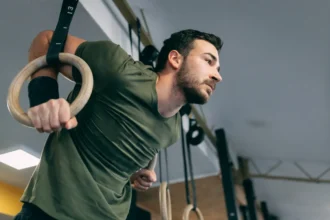High school sports provide an opportunity for young athletes to push their physical limits, develop discipline, and hone their competitive edge. However, not all sports are created equal when it comes to physical and mental demands.
Based on athlete perspectives, certain sports stand out for their exceptional intensity, requiring grit, endurance, and resilience. Here are the top five hardest high school sports, according to athletes:
1. Wrestling
Wrestling is often cited by athletes and experts alike as one of the most challenging high school sports. With its combination of combat, endurance, and strategy, wrestling pushes athletes to their limits in several key areas:
Physical Demands
Wrestling is one of the most physically intense sports, requiring athletes to use nearly every muscle in their bodies. Matches are often short, lasting only six minutes, but those six minutes are filled with intense physical exertion. Wrestlers must be able to perform rapid bursts of explosive strength while also maintaining a high level of cardiovascular fitness.
Wrestling matches also involve constant grappling, pushing, pulling, and lifting, which require incredible functional strength and endurance. Athletes must be prepared to withstand physical exhaustion while continuing to execute complex moves with precision.
Weight Management
One of the unique challenges of wrestling is the need to compete in weight classes. Wrestlers are divided into classes based on their body weight, which leads to many athletes focusing on strict diet and weight management practices. This process can be grueling, as it often involves:
- Cutting weight: Wrestlers may need to lose weight rapidly to qualify for a particular weight class. This often involves restrictive eating, dehydration, and intense workouts just before a weigh-in. The process of “cutting” can be mentally and physically taxing, as it requires extreme discipline.
- Maintaining weight: After making weight, athletes must maintain their strength and energy levels for competition. Balancing nutrition, hydration, and weight control is a delicate process, and wrestlers often struggle to ensure they stay within their weight class without sacrificing performance.
The pressure to meet weight requirements can be particularly intense during high school years when athletes are still growing and developing. The mental and physical toll of weight management makes wrestling stand out from other sports.
Technical Skills
Wrestling is not just about raw strength or speed—it requires a deep understanding of technique and strategy. There are countless moves, holds, and counters that wrestlers must learn and master. Each move has its own timing, balance, and leverage, and athletes must know how to react in different situations.
Key technical skills in wrestling include:
- Takedowns: Wrestlers spend a significant amount of time practicing takedowns, which involve bringing an opponent to the mat from a standing position. There are various types of takedowns, each requiring precise timing and technique.
- Reversals: During a match, wrestlers may find themselves in disadvantaged positions. Reversals are moves that allow a wrestler to turn the tables on their opponent and gain control.
- Escapes: Wrestlers must also learn how to break free from an opponent’s hold or grip. This requires a combination of strength, agility, and quick thinking.
- Pins: The ultimate goal in wrestling is to pin an opponent to the mat. Achieving this requires both physical dominance and the ability to hold an opponent in place without allowing them to escape.
To master these skills, wrestlers often engage in repetitive drills and sparring sessions, honing their technique until it becomes second nature. The need for constant improvement and refinement of technical skills makes wrestling a sport that challenges both body and mind.
2. Gymnastics
Gymnastics is one of the most challenging high school sports due to its combination of physical strength, flexibility, balance, and mental focus. Athletes must master a variety of apparatuses and skills, requiring both technical precision and artistic performance.
Physical Demands
Gymnastics is a full-body sport that requires athletes to be in peak physical condition. Each apparatus—whether it’s the balance beam, uneven bars, vault, or floor exercise—demands specific physical skills that athletes must develop and maintain through rigorous training.
Key areas of physical demand in gymnastics include:
- Strength: Gymnasts need extraordinary upper body and core strength to perform skills like handstands, flips, and swinging maneuvers on the bars. Strength in the legs is also essential for vaulting and powerful tumbling passes. Gymnasts train extensively with bodyweight exercises such as pull-ups, push-ups, and core strengthening drills to build this foundational strength.
- Flexibility: One of the defining characteristics of gymnastics is its emphasis on flexibility. Athletes need to maintain a high degree of flexibility to perform splits, leaps, and other skills that require extended ranges of motion. Daily stretching routines are vital to prevent injury and to allow gymnasts to achieve the graceful lines expected in their routines.
- Coordination and Balance: Gymnasts must have impeccable coordination and balance to execute complex skills, especially on the balance beam or during tumbling sequences. Any loss of balance or misstep can result in point deductions or serious injury, making these physical attributes critical for success.
Training for gymnastics typically involves hours of repetition to perfect these physical elements. Gymnasts will spend significant time each week building their strength, flexibility, and coordination, all while refining their skills on each apparatus.
Technical Skills and Precision
One of the defining features of gymnastics is its emphasis on technical precision. Gymnasts are judged on their ability to perform complex skills with flawless form. Every movement is scrutinized, from the angle of a gymnast’s toes in a handstand to the execution of a leap or tumbling pass.
Gymnasts spend countless hours practicing:
- Handstands and flips: These are foundational skills that every gymnast must master. Handstands form the basis of many skills on the beam and bars, while flips are essential for tumbling passes on the floor and vault.
- Turns and leaps: On both floor exercise and beam, gymnasts must execute leaps and turns with perfect form. Judges look for extension, height, and smooth execution. Practicing these seemingly simple moves requires years of dedication to ensure they are performed without flaws.
- Bar transitions: On the uneven bars, gymnasts must swing between the two bars with perfect timing and momentum. The transitions between the low and high bars are technically challenging and require great strength and body control.
In addition to mastering the skills on each apparatus, gymnasts must also link these elements together into routines. These routines are choreographed to showcase the gymnast’s abilities, with each movement flowing seamlessly into the next. The precision and complexity of these skills are what make gymnastics such a demanding sport.
Long Hours of Training
High school gymnasts often dedicate many hours each week to training. Practices can last several hours a day, five or six days a week. The intense nature of gymnastics training means that athletes must juggle school, homework, and practice while ensuring they get enough rest and recovery.
Due to the time demands of training, high school gymnasts must manage their time efficiently. Balancing academics, social life, and gymnastics training can be challenging, and many athletes must make sacrifices to stay competitive.
3. Ice Hockey
Ice hockey combines speed, power, and endurance, making it one of the most demanding high school sports. Played on ice, athletes must have excellent skating skills while simultaneously managing puck handling, passing, and shooting. Hockey is also a contact sport, meaning players must be tough enough to withstand body checks while maintaining their focus on the game.
Physical Demands
Ice hockey is an intensely physical sport that demands strength, agility, endurance, and resilience. The sport’s unique environment—being played on ice—adds an extra layer of difficulty, as athletes must be skilled skaters in addition to being proficient with the stick and puck.
Hockey players train to maintain agility and speed while building the strength needed for physical confrontations. Conditioning, speed drills, and strength training are essential parts of their regimen.
High Physical Intensity and Contact
Ice hockey is a physical sport, with body checks and battles along the boards being common occurrences. The physicality of the game adds a significant challenge, as players must not only focus on their skating, puck control, and positioning but also be prepared for constant physical contact from their opponents.
Some key aspects of the physical intensity in ice hockey include:
- Body checking: Players are allowed to use their bodies to check opponents, which means collisions are frequent and often violent. Checks can be delivered to disrupt an opponent’s play, gain possession of the puck, or create space for a teammate. Athletes must be tough enough to withstand these hits and deliver their own without compromising their positioning or focus.
- Battles along the boards: Much of the game happens along the boards, where players fight for control of the puck. These battles require strength, balance, and mental toughness, as athletes are often pinned against the boards while being checked by opponents.
- Physical endurance: Despite being a high-contact sport, ice hockey is also one of the most endurance-driven games. Players are constantly moving, and their bodies take a beating from the high-impact nature of the sport. The ability to recover quickly between shifts is essential, as the game’s fast pace means there’s little time to rest.
High school hockey players train extensively to build the physical toughness required for the sport. Weight training and body conditioning help athletes withstand the rigorous physical demands, while drills during practice prepare them for the high-contact nature of games.
Technical Skills
Mastering the technical aspects of ice hockey is essential for success. Athletes must develop a range of skills, from stick handling and passing to shooting and defensive positioning. All of this must be done while moving at high speeds on skates, making the technical demands of the sport extremely challenging.
Key technical skills in ice hockey include:
- Stick handling: Players need to be able to control the puck with their stick while skating. Stick handling involves dribbling the puck, making quick passes, and faking out opponents with dekes and moves to maintain possession of the puck.
- Passing: Accurate passing is essential in ice hockey, as the game moves so quickly that split-second decisions can make the difference between scoring a goal or losing possession. Players need to be able to pass the puck while skating, often under pressure from opponents, and anticipate where their teammates will be in fast-moving plays.
- Shooting: Scoring goals in hockey requires precise shooting. Players need to develop powerful slap shots, wrist shots, and snap shots, all while aiming to hit small areas of the net. Shooting is often done under pressure, with defenders and the goalie trying to block shots, so accuracy and speed are crucial.
Players practice these skills relentlessly, both in individual drills and team settings, to develop the precision and control necessary for success. The ability to perform these technical skills while skating at full speed under pressure from opponents is what makes hockey so technically demanding.
4. Water Polo
Water polo is often underestimated, but it is one of the most physically demanding sports. Played in deep water, athletes must tread water and swim continuously throughout the match. The sport combines elements of swimming, handball, and basketball, making it physically and mentally exhausting.
Physical Demands
One of the most significant challenges of water polo is that the game is played entirely in deep water, meaning players must constantly tread water or swim. This is known as the “eggbeater kick,” a powerful and efficient method of treading water that allows players to stay afloat while keeping their upper bodies free to throw, catch, and defend.
High school water polo players are required to have excellent cardiovascular fitness to keep up with the nonstop movement in the water. Athletes must also maintain upper body strength to throw and catch the ball, while using their legs to tread water or stay afloat in the deep end of the pool.
Water polo players engage in rigorous training, often swimming for miles during practice sessions to build endurance, while also incorporating strength training and conditioning exercises to improve their ability to perform the demanding skills required in the game.
Technical Skills
Water polo requires a combination of swimming skills and ball-handling abilities, similar to those used in soccer or basketball. Players must be able to swim with speed and agility while also controlling the ball, passing accurately, and shooting on goal, all while staying afloat and resisting physical challenges from their opponents.
Key technical skills in water polo include:
- Ball handling: Players need to handle the ball with one hand (as per water polo rules) while treading water and avoiding defenders. Dribbling the ball down the pool, making quick passes to teammates, and taking powerful shots on goal are essential skills that require precision and control.
- Shooting: Shooting in water polo is an art. Players must be able to rise out of the water using their legs, balance themselves, and throw the ball with speed and accuracy, often while under pressure from a defender. Shots must be aimed precisely to beat the goalkeeper, who is also treading water and moving to block the shot.
- Passing: Water polo is a team sport that relies on quick, accurate passing. Players need to pass the ball efficiently to create scoring opportunities and keep the game flowing. Passing under pressure requires both physical strength and tactical awareness, as players must read the game and anticipate where their teammates will be.
Players spend significant time in practice working on their swimming, ball-handling, and shooting techniques, all while developing their ability to perform these skills under the pressure of physical contact and game situations.
5. Cross Country
Cross country might seem simple compared to other sports on this list, but it is one of the hardest due to its sheer mental and physical endurance requirements. Athletes run long distances over varied terrain, often in adverse weather conditions such as rain, wind, or intense heat.
Physical Demands
The primary challenge of cross country is the sheer physical endurance required to run long distances over rough and uneven terrain. Unlike track running, which takes place on smooth, predictable surfaces, cross country courses include hills, mud, grass, and gravel, making it harder to maintain a consistent pace.
Races typically range between 3 and 5 miles (5 to 8 kilometers), depending on the level of competition, and runners need to be prepared to perform at peak levels for extended periods.
Cross country runners spend a significant amount of time training to improve their aerobic capacity, leg strength, and core stability. They often run hundreds of miles throughout a season, gradually building the endurance needed to compete at a high level.
Technical Skills
While cross country may seem like a straightforward sport—running from start to finish—there are key technical skills that runners must master to perform well. These skills include pacing, race strategy, and navigating difficult terrain, all of which require a high level of awareness and adaptability.
Key technical skills in cross country include:
- Pacing: Cross country runners must master the art of pacing, knowing when to push hard and when to conserve energy. Starting too fast can lead to burnout later in the race, while starting too slow can leave a runner with too much ground to make up. Successful runners find the right balance, pacing themselves based on the course and the competition.
- Race strategy: Races are not just about physical ability; they also involve strategy. Runners must be able to assess the competition, manage their energy levels, and decide when to make a move. For example, on a hilly course, a runner might conserve energy going uphill and then surge on the downhill section.
- Terrain navigation: Cross country courses are often unpredictable, with hills, mud, uneven footing, and sharp turns. Runners need to adjust their stride and approach based on the terrain, adapting to changes in elevation and surface conditions. Running on grass or dirt is different from running on pavement, so cross country runners practice on varied surfaces to prepare for race day.
Coaches often design training sessions that simulate race conditions, helping athletes improve their pacing, strategy, and ability to handle difficult terrain.
Environmental Challenges
One of the most unique aspects of cross country is that it is run outdoors on natural terrain, which means athletes must be prepared to compete in a wide range of weather and environmental conditions. From hot, sunny days to cold, muddy courses, cross country runners face constant challenges from the elements.
Runners train for these challenges by practicing in various weather conditions and on different terrains, ensuring that they are prepared for whatever the course might throw at them on race day.
Conclusion
These sports show just how dedicated and tough high school athletes are. It takes more than just being strong and fit – you need mental strength and a love for the sport to succeed. Each sport has its own challenges, and what’s hardest really depends on the person.













